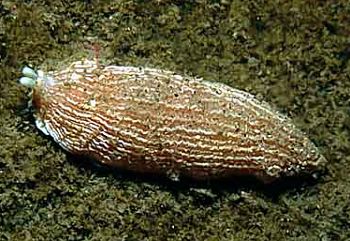
Armina loveni
(Bergh, 1860)
Order: NUDIBRANCHIA
Suborder: ARMININA
Family: Arminidae
DISTRIBUTION
North eastern Atantic from southern Norway to the Atlantic coast of France, including the British Isles.
PHOTO
En Ceann Feidh, Loch Nan Uamh near Arisaig on the west coast of Scotland. April, 2001. Found crawling across the silt covered sloping rock surface at 24 metres, a 36mm long individual. PHOTO: Jim Anderson.
There are few records of this distinctive nudibranch probably because it burrows into soft sediments. It can reach 40 mm in length. The mantle is a reddish colour, with up to 50 prominent white longitudinal irregularly wavy ridges. In places the ridges can be replaced by a row of pustules. The mantle rim contains numerous large defensive glands (brown in preserved animals). According to Thompson (1988)Armina loveni is always found in mud, in sheltered localities, among beds of the pennatulacean cnidarian Virgularia mirabilis, on which it feeds. See photo on Bernard Picton's nudibranch site showing Armina feeding [http://www.pictonb.freeserve.co.uk/nudibranchs/armlov.html]. Subtidal species to 75 m depth.
Reference:
• Thompson, T.E. (1988) Molluscs: Benthic Opisthobranchs (Mollusca: Gastropoda). Synopses of the British Fauna (New Series). No. 8. 2nd Edition. E.J.Brill/W. Backhuys: Leiden. 1-356.
Rudman, W.B., 2001 (December 3) Armina loveni (Bergh, 1860). [In] Sea Slug Forum. Australian Museum, Sydney. Available from http://www.seaslugforum.net/find/armilove
Related messages
Re: Juvenile shape compared to an adult's
March 1, 2004
From: Jussi Evertsen
Hi all!
Following Sakkies's message [#12321]:
This is more like an anecdote to the topic of an arminid nudibranch appearing in large numbers and not being seen since. Here in the Trondheimsfjord we have had a peculiar observation of Armina loveni. According to Dons (1933) it appeared for the first time in 1933 (after 13 years of continuous survey). It was then a common catch from 1933 to 1939 (Odhner 1939). Since then we have not seen this species from the Trondheimsfjord, although is assumed in the literature to feed on the sea pen Virgularia mirabilis, which is quite common in the fjord.
It might be that A. loveni has a reproductive limit this far up the Norwegian coast, and that it in the 1930's had had a sucessful survival of offspring for a time. According to Dons (1930), the shallow water temperature of the fjord from 1925 to 1930 were higher than normal. The food seems abundant, so we might have to wait for another "warm" period for it to appear.
• Dons, C. 1934. [for 1933]. Zoologische Notizen XXIV. Uber die Verbreitung der Pleurophyllidia loveni. Det Kongelige Norske Videnskabers Selskabs Forhandlinger, 6(48): 183-184.
Sincerely
Jussi Evertsen
www.nudibranchia.no
jussi.evertsen@bio.ntnu.no
Evertsen, J., 2004 (Mar 1) Re: Juvenile shape compared to an adult's. [Message in] Sea Slug Forum. Australian Museum, Sydney. Available from http://www.seaslugforum.net/find/12330Thanks Jussi,
Bill Rudman
Re: Armina loveni and its food
December 14, 2001
From: Bernard Picton
Hi Bill,
I have a picture on my nudibranch site showing an Armina giving a Virgularia a bit of close attention - I think it was eating it! You say feeding hasn't actually been observed.
http://www.pictonb.freeserve.co.uk/nudibranchs/armlov.html
Bernard
bernard.picton.um@nics.gov.uk
Picton, B.E., 2001 (Dec 14) Re: Armina loveni and its food. [Message in] Sea Slug Forum. Australian Museum, Sydney. Available from http://www.seaslugforum.net/find/5838Thanks Bernard,
Sorry I missed your photo - correction made
Cheers,
Bill Rudman
Armina loveni from Scotland
December 11, 2001
From: Jim Anderson

Dear Bill,
Here is a photo of Armina loveni from Scotland
En Ceann Feidh, Loch Nan Uamh near Arisaig on the west coast of Scotland. April, 2001.
Found crawling across the silt covered sloping rock surface at 24 metres, a 36mm long individual.
Jim Anderson
jander4454@aol.com
Anderson, J., 2001 (Dec 11) Armina loveni from Scotland. [Message in] Sea Slug Forum. Australian Museum, Sydney. Available from http://www.seaslugforum.net/find/5732Thanks Jim,
Bill Rudman
